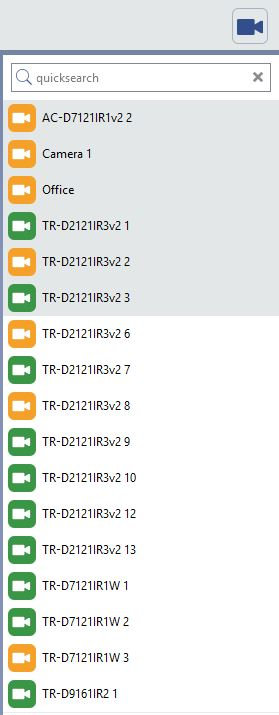Channel list is displayed on the right part of the screen. Channels are displayed in alphabetical order, but you can change the order by dragging the channel to the requested place.
Left click on the channel to spread the video to the entire main area.
The channel list can be hidden or displayed with the button  . To see the name of the channel change the list width. Click again on the list view button or drag the list with the mouse.
. To see the name of the channel change the list width. Click again on the list view button or drag the list with the mouse.
The channel list displays:
- Local channels - channels of the devices connected to this server directly.
- Network channels -channels of the devices connected to another TRASSIR server over a network.
- Cloud channels - channels connected to TRASSIR Cloud.
- Archived channels - channels that transfer video data through the archive merge.
Switching the tabs you can display the channels connected to the server, all of them or cloud channels only. Besides, to find the name of the channel, enter it to the quick search field. Those satisfying the search conditions will remain in the list.
If too many channels exist, you can group them to save the space and make it easy to use. To do this:
- Press CTRL or SHIFT and without releasing, select the required channels.
- In the context menu select Assign group.
- Enter the name of the group and press OK.
Tip
You can place all the lost channels into one group, select Group lost channels.
Important
To access the channels in the group left click the group icon.
To cancel the group, select the channel in this group and without releasing the mouse button, drag it to the required place in the channels list.
Each channel or group of channels in the list is characterized by one of the following icons:
Table 89.
| Local and network channels | Cloud channels | Archived channels | Group of channels | Description |
|---|---|---|---|---|
 |
 |
 |
 |
Signal on. No motion |
 |
 |
Motion detection is performed in the source server. |
 |
Signal on. Motion detected. To detect a motion a motion detector should be configured on the channel. |
 |
Archived is saved to the cloud. |
 |
 |
Signal on. Archive is not saved. |
 |
 |
 |
 |
No video signal. |
 |
 |
 |
 |
Lost channels. There is a archive, but no video recording equipment. |


